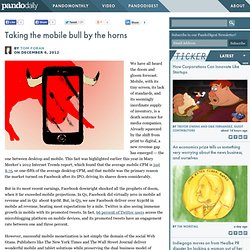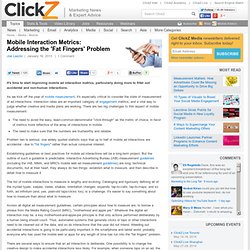

Statistics: Mobile Marketing. Apr 11, 2014 at 6:16pm ET by Greg Sterling A trio of reports sheds new light and visibility on how TV and digital video viewing habits are changing with social media in the multi-platform era.

Viewing habits are shifting dramatically in large part because of on-demand viewing and the availability of programming across screens. According to the Ooyala Global Video Index (for Q4 2013), based on behaviors observed across its network of video publishers, smartphones and tablets are grabbing a larger share of video viewing time. The report looked video consumption on connected TVs, video on PCs, tablets and smartphones. While there [...] Related Topics: Channel: Video | Google: YouTube | Statistics: Mobile Marketing | Statistics: Popularity & Usage | Statistics: Social Media Apr 11, 2014 at 10:22am ET by Greg Sterling The strategic importance of apps is now self-evident, with roughly 90 percent of mobile internet time being spent there, according to Nielsen. 65 percent of US smartphone shoppers prefer to use mobile Web to mobile apps for shopping. Is that shocking? It shouldn’t be.
Submitted by Editor on 14 May, 2013 - 20:04.

A recent survey by Google of 1,500 smartphone shoppers (i.e. smartphone users who used their devices for shopping purposes) in the US, found the majority preferred to use mobile Web above mobile apps when researching products and prices in-store. Shoppers have always shopped around for the best deal and any retailer that thinks they won’t use their mobile device to do that – whether they are in-store or not – is living in cloud cuckoo land. No matter how good your physical store, consumers can leave and check out the competition. No matter how good your app, consumers can leave and check out the competition. Mobile Web v mobile app What is more interesting, perhaps, is how these smartphone shoppers perform these tasks i.e. via mobile Web or mobile app.
Some shoppers might use native apps to conduct their retail research, but most won’t. What about a price-comparison app or a search app? Taking the mobile bull by the horns. By Tom Foran On December 6, 2012 We have all heard the doom and gloom forecast.

Mobile, with its tiny screen, its lack of standards, and its seemingly inordinate supply of inventory, is a death sentence for media companies. Already squeezed by the shift from print to digital, a new revenue gap has emerged — the one between desktop and mobile. This fact was highlighted earlier this year in Mary Meeker’s 2012 Internet Trends report, which found that the average mobile CPM is just $.75, or one-fifth of the average desktop CPM, and that mobile was the primary reason the market turned on Facebook after its IPO, driving its shares down considerably.
What’s working in mobile advertising — and what might work in the future. As Mary Meeker, the Queen of the Internet, made clear earlier this year, mobile is on the wrong side of a monetization gap.

While consumers are spending more and more time on mobile devices, advertising revenue there is still lagging well behind traditional online — some $30 billion was spent in online advertising last year in the U.S. vs. $1.6 billion for mobile ads. Ad rates on mobile are 5 times lower than on desktop. Mobile Interaction Metrics: Addressing the 'Fat Fingers' Problem. Joe Laszlo | January 16, 2013 | 1 Comment inShare46 It's time to start improving mobile ad interaction metrics, particularly doing more to filter out accidental and non-human interactions.

As we kick off the year of mobile measurement, it's especially critical to consider the state of measurement of ad interactions. The changing landscape of app discovery. [The explosive growth of app ecosystems is creating serious bottlenecks in app discovery that only popular apps can overcome.

Having 700 thousand apps is great for platform vendors, but not so great for developers, whose apps are lost in the heap. Andreas Pappas takes a look at the app discovery problem and considers whether social discovery is a better solution than the alternatives available today] This article is also published in our newly launched Developer Economics Portal – where you can find more solutions to the app discovery issue. One of the greatest marketing challenges facing developers is being discovered, i.e. breaking through app store congestion and in front of user eyeballs. Push Messaging & Push Marketing Solutions.
2013 Global E-Commerce Trends: More Personal, More Mobile, More Channels. 2012 was a great year for e-commerce, for both consumers and marketers alike.

And from the looks of it, 2013 is shaping up to be even better. In 2012, consumers who were once wary of virtual buying, continued to increase their spending online, where they’ve discovered that better optimized and personalized sites are starting to offer them a richer, more relevant online experience. Marketers, once dependent on gut instinct and guessing games, now use easy-to-use, sophisticated tools to create sites driven by real-time user behaviors and data. But as much as e-commerce has evolved, 2013 promises to be full of even more great leaps forward for consumers — and for the online businesses that serve them. More channels and devices are digitally disrupting the market, and consumers are more fickle than ever. Thanks to smarter marketing and better technology, 2013 just might be the year we see a real shift in how close consumers and companies can really become.